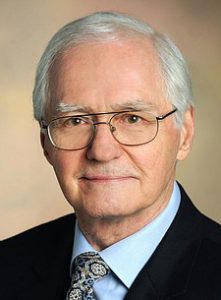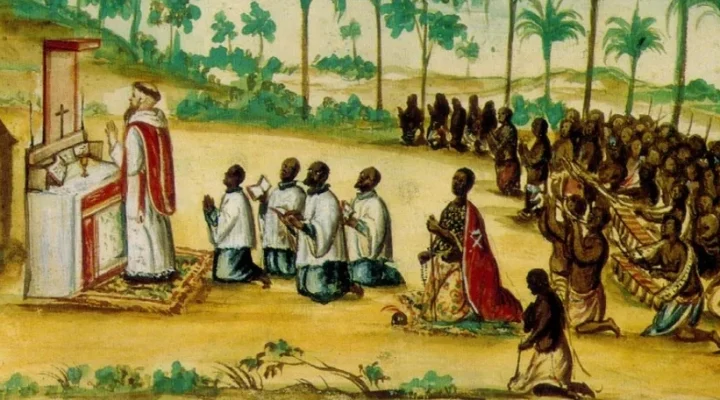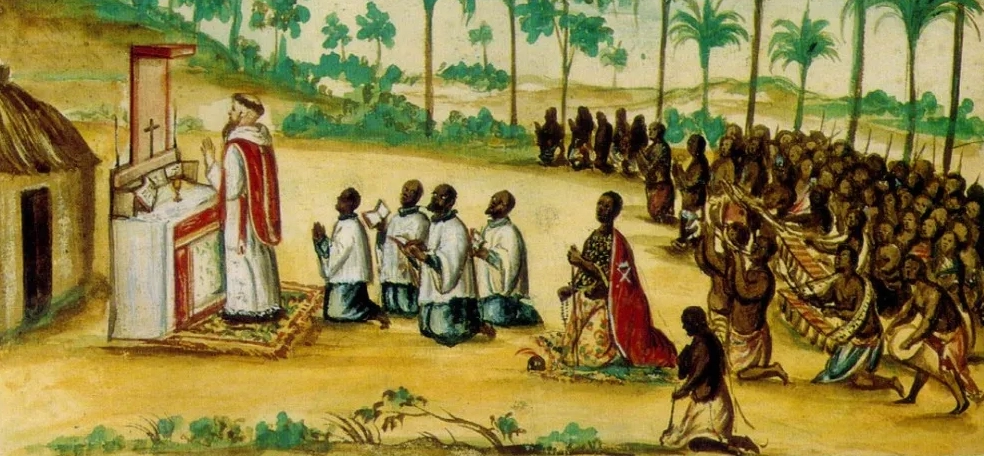Inertia. Think back to high school, maybe physics class. Yes, that inertia: “a property of matter by which it remains at rest or in uniform motion in the same straight line unless acted upon by some external force.”
History certainly is not matter, but it surely does roll along behind us, like a soccer ball rolls across the field, carried by inertia until the “external force” of the grass and uneven ground stops it.

Richard Conville
Sometimes historical inertia is powerful and long-lived. To this day, we struggle under the sway of a unique stream of history that was ignited in the Western hemisphere 568 years ago, when Pope Nicholas V issued his edict, Romanus Pontifex in 1455. It gave King Alfonso of Portugal (and by extension, all the monarchs of Europe) the right to invade, search out, capture, vanquish and subdue all Saracens (Muslims) and pagans whatsoever, and other enemies of Christ wheresoever placed … and to reduce their persons to perpetual slavery.
This ruling by Pope Nicholas, along with several others issued in the 15th century, have come to be known as the Doctrine of Discovery. It became the moral justification for enslaving millions of Africans for work on the sugar plantations of South America and the Caribbean, and later, on the cotton plantations of the American South. And the international slave trade flourished because of it.
By the time the American colonies declared their intention to separate themselves from the British crown, African slavery was a centuries old institution in the Western hemisphere and had been planted on current U.S. soil 157 years earlier (1776-1619). By then, the inertia of Christian, European (white) supremacy had been rolling, like that soccer ball, for 321 years (1776-1455). The worldwide demand for cotton and the fortunes to be made using the cheap labor of enslaved persons kept it rolling.
After the Civil War ended U.S. slavery, then came the Jim Crow era when white citizens successfully stripped Blacks of voting rights, subjected them to discriminatory laws, and most former slaves were bound to the land by tenant farming arrangements. The Doctrine of Discovery was still very much alive.
The Black population was held in check by the Ku Klux Klan. As Professor William Sturkey has reminded us (Hattiesburg, An American City in Black and White), “Between 1890 and 1910, white Mississippians lynched nearly 350 African Americans.”
After the 1954 Brown decision, White Citizens’ Councils (Doctrine of Discovery-Lite), held the Black population in check well into the 1960s. Emmett Till was murdered in 1955; Medgar Evers in 1963; Martin Luther King in 1968.
Thirty years on, the Doctrine of Discovery again reared its ugly head. It was during Ole Miss President Robert Khayat’s 1997 “image review” that included the university’s Confederate symbols — the mascot, Colonel Reb, the band playing Dixie and the team nickname, Rebels. In his memoir, The Education of a Lifetime, Khayat recounted one particularly concerning death threat.
“The Doctrine of Discovery thrives in certain quarters.”
“I put on my glasses and picked up the handwritten note. It opened, Dear Traitor, It is clear from your last name that you were not born in the United States of America. The writer went into a diatribe of cursing and accusations, not unlike hundreds of other letters we had received. But then, it took a turn. Try as you may to vilify our heritage and spit on the graves of our ancestors, but I can promise you will never live to see that day. You may think you are safe, but you will never see us coming. Your family will never see us coming. I handed the letter back to the police officer. ‘What do we do about this?’ I asked.”
Today, nearly three decades after 1997, the Doctrine of Discovery thrives in certain quarters — such as the Rankin County Sheriff’s Department with its self-identified “goon squad.” According to federal law enforcement reports compiled by Jerry Mitchell of the Mississippi Center for Investigative Reporting at Mississippi Today, on Jan. 24 of this year, the five officers (all white) burst into Terrell Parker’s residence in Braxton, Miss., without a warrant, beat and tortured Parker and his friend, Michael Jenkins (both Black) and told them to stay on their side of the Pearl River.
The Doctrine of Discovery insists on rolling on, infecting successive generations. What “external force” will slow it down? Understanding it is a start.
Scholar of contemporary American Christianity, Robert P. Jones now considers the Doctrine of Discovery “a kind of Rosetta Stone for understanding the deep structure of the European political and religious world views we have inherited in this country. … Ideas such as Manifest Destiny, America as a city on a hill, or America as a new Zion all sprouted from the seed” of the Doctrine of Discovery, planted in the 15th century.
So far, we have not been good stewards of our inheritance.
Richard Conville is a retired professor of communication studies and long-time resident of Hattiesburg, Miss. This column was previously published in The Pine Belt News, Hattiesburg.
Related articles:
To understand white Christian nationalism, look to Doctrine of Discovery, Jones says
BJC luncheon highlights ongoing oppression of Native Americans


